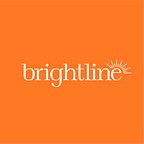It’s World Mental Health Day and the Birth Day of Brightline
I will never forget the sinking feeling in the pit of my stomach at our first back-to-school night for our son, Matteo, who had just entered kindergarten. The kids had done drawings and labelled them with neat block words, “cat”, “ball”, and their own names. They hung proudly in little rows across the classroom walls, a testament to an industrious first week of school.
As my eyes wandered across the class I saw one drawing that was not like the others. It was much more rudimentary, just a jumble of lines that didn’t connect, with no labels or words… and it was missing a child’s name. Later in the evening my son proudly brought it to me as his first “kinder-art”. I had already realized his handwriting was poor for his age but it dawned on me at that moment that he wasn’t even close to where the other kids were.
Over the course of kindergarten, we realized Matteo simply wasn’t tracking on a number of dimensions like basic handwriting or his ability to hold utensils. He also used baby talk and gestures often. Over the year, he developed stronger sensitivities to loud sounds, foods, things he perceived as scary. He wailed at things other kids loved, like Moana or Cars. I kept asking myself “Is this normal?”
As a mom, I felt terrified and lost.
We tried to get him support through his school but they didn’t seem overly concerned or even invested in helping us understand what he needed. We spent months on waiting lists for occupational therapy. We finally sent him for a handwriting camp and spent $600 out of pocket, but got zero assessment, no feedback on how he was tracking, nor communication on what we needed to do to support him.
The experience was time-consuming, full of dead ends, and left us frustrated and bewildered. Oh — and it was incredibly expensive out-of-pocket.
Today (through a lot of hustle and time) we have found some good help for Matteo. But each day I look around at friends and families who are dealing with much harder mental and behavioral health challenges than we are. And I see their frustrating and often heart-breaking struggles. My talented senior product leader friend who quit her job to be able to manage her son’s autism treatment. The neighbor who is struggling to manage her teen’s depression and technology addiction. The couple we love who are constantly fighting because they don’t agree on the support their tantruming daughter needs.
We are not alone.
Child and adolescent behavioral health is one of the most pressing societal and economic problems in the United States… Twenty percent of all children have a diagnosable behavioral health issue (and that’s not including undiagnosed), but only twenty percent of those children receive any form of treatment (CDC). Anxiety, depression and behavior disorders are on the rise. Over 17M children in the US have mental health issues, making it more prevalent than pediatric cancer, diabetes and AIDS combined. Mental health spending for children is currently $8.9B annually in the US, one of the largest spend areas for child health (Journal of Pediatrics).
The current system is broken.
The current “system” of care for behavioral health is fragmented (individual therapists and providers don’t talk to each other). Access is limited (almost half the counties in the US don’t have any mental health providers). And it’s incredibly expensive (there’s virtually zero insurance coverage for many services).
Moreover, the experience for families is terrible.
Anyone trying to get care for their kids knows the experience of callbacks to the therapists offices, long wait times to be seen, arduous scheduling and intakes, out of pocket costs and complex insurance processes. And for parents like my husband and myself, there’s no enabling digital support to tell us how our son is progressing and what we can do to help him. We are able to and want to help but simply don’t have the ways to know what to do.
Introducing Brightline
Today, on World Mental Health Day, I’m thrilled to announce my new business venture, Brightline. I am leaving a wonderful role at an incredible company, Livongo, to be the CEO and co-founder of Brightline, partnering with an exceptional team of serial entrepreneurs and backed by Oak HC/FT’s Annie Lamont.
Brightline is building the world’s first technology-enabled Behavioral Health Home for children and their families. We are doing three things that have never existed in behavioral health:
- Creating a radically great service experience: From the moment you experience Brightline, you feel like you’re being taken care of. We are taking the friction out the behavioral health experience by creating seamless and digital intake, scheduling, finding a great therapist. We are building a truly child-centered clinic environment. Your family’s Care Navigator supports each step of the process.
- Building a live-and-digital care continuum: We are wrapping our live clinical support with a digital experience for kids and their parents/caregivers. For kids, we can provide specific digital interventions and exercises based on their needs. For parents we can provide a “parallel track” to support parents in helping their children.
- Defining a new care collaboration model: We are standing up integrated collaboration models and protocols that support the whole child’s behavioral health and adjacent needs, whether that child needs talk therapy (CBT, DBT, other), occupational therapy, other forms of therapy. We are keeping the whole health ecosystem informed (pediatricians, school counselors).
We can’t wait to launch our first Brightline clinics and digital platform in 2020. Visit our website to sign up for updates to learn when we will launch Brightline near you. And visit us at Angel List for job opportunities.
